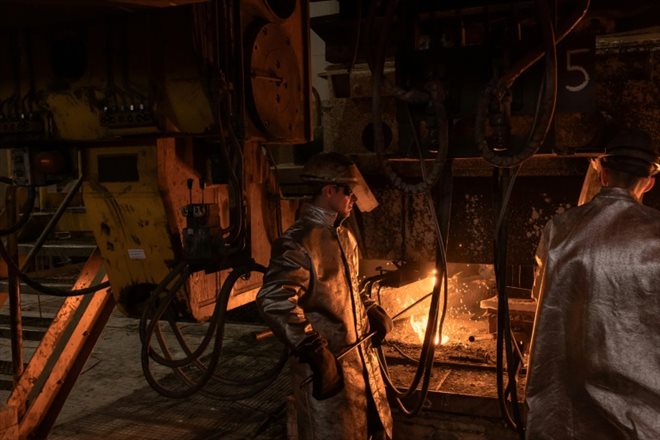An employee works at the Zaporizhstal steelworks on September 21, 2023 in Zaporizhia, southern Ukraine (AFP/Andrii KALCHENKO)
Wearing a heat-protective coat with hood and visor, Serguii gazes into an incandescent orange stream of liquid metal at the Zaporizhstal steelworks in Zaporizhia, southern Ukraine.
The blast furnace worker checks the casting of molten pig iron at a temperature of around 1,400 degrees for possible impurities. Work carried out just 40 kilometers from the fighting.
Since the Russian invasion, Ukraine’s metal industry, located mainly in regions near the front line, has lost factories, staff, suppliers and access to vital export centers.
According to World Bank estimates, during the first year of conflict, the Ukrainian economy suffered damage and losses of around $411 billion.
Zaporizhstal belongs to the steel and mining group Metinvest, controlled by Rinat Akhmetov, the richest man in Ukraine.
“We have a fundamental task: to save the company, to save our assets, to survive,” Oleksandr Myronenko, chief operating officer of Metinvest, told AFP.

Oleksandr Myronenko, chief operating officer of Metinvest, during an interview with AFP at the Zaporizhstal steelworks, September 21, 2023 in Zaporizhjia, southern Ukraine (AFP/Andrii KALCHENKO)
Steel mills such as Zaporizhstal are essential to Ukraine’s economy, and maintaining production – even at lower levels – is a testament to the sector’s resilience.
The Zaporizhstal plant is a sprawling network of pipes, roads, railways and warehouses. In one building, a sign dating from the Soviet era announces production records.
On a blackboard, someone wrote: “Putin is an asshole!”
– An alternative: go and fight –
Despite nearby fighting, Oleksandr Myronenko says Zaporizhstal produces about 70% of pre-war volumes, with the bulk going to the United States or Europe.

An employee works at the Zaporizhstal steelworks on September 21, 2023 in Zaporizhia, southern Ukraine (AFP/Andrii KALCHENKO)
“I expect that we will produce more steel than in 2022,” he assures, although exports are hampered by the Russian blockade of Black Sea ports and the bombing of the Danube port of Izmail.
Last month, Metinvest managed to ship cargo on three ships via the Black Sea, but according to Mr. Myronenko, shipowners are afraid to send more ships.
Like the ports, the Zaporizhia factory is threatened by Moscow’s strikes. It has bomb shelters, but some workers cannot leave their posts.
“It’s scary, but what can you do? You have to feed your family,” explains Serguiï, 30, letting off cascades of sparks as he tests the molten metal.

Employees in protective equipment work at the ArcelorMittal steelworks, in Kryvyi Rig, on September 15, 2023 in southern Ukraine (AFP/Archives/Roman PILIPEY)
“There is only one alternative: to go and fight,” he says.
Around eight thousand Metinvest employees were mobilized or volunteered to fight, while in Ukraine’s largest steel plant, ArcelorMittal’s in Kryvyï Rig, 2,600 went to the front, with more than a hundred killed.
– “Together towards victory” –
Zaporizhstal has seen around a third of its 10,500 employees leave since the invasion. Due to production cuts, some employees have been forced to take forced leave, while others are struggling or have relocated.

The Zaporizhstal steelworks, May 10, 2022 in Zaporizhia, southern Ukraine (AFP/Archives/Dimitar DILKOFF)
A billboard at the entrance to the factory reads: “Together towards victory”.
The plant shut down its furnaces after the Russian invasion and suspended its water-cooled equipment this summer after the Kakhovka hydroelectric dam failed.
“War dictates its own conditions,” notes Vladislav Tyurin, a 39-year-old foreman.
Of the 350 people in his workshop, 65 went into combat and four were killed.
An employee and three people were injured last December when Russian missiles hit the factory’s territory.
When the air alert sirens mix with the roar of the machines, “we are afraid,” he admits.
Vitaly, another 33-year-old foreman, said that a week earlier, Russian forces bombarded the region with rockets and drones.
“We sat until 9 a.m. in a fallout shelter. The drones were flying and so were the rockets,” he says.

An employee at the ArcelorMittal steelworks, in Kryvyi Rig, on September 15, 2023 in southern Ukraine (AFP/Archives/Roman PILIPEY)
ArcelorMittal said in a statement that it had put in place “alternative logistics schemes” for the factory, under “extremely difficult conditions”.
The company exported 85% of its finished products mainly to the Middle East and Africa. Now most of it is destined for Europe.
Although he admits “negligible” production compared to pre-war production, Mr. Tyourin assures that the steel from the factory will be necessary for the reconstruction of Ukraine after the conflict.
The Russians “destroyed part of the country. For restoration and construction we will need metal products,” he says.
© 2023 AFP
Did you like this article ? Share it with your friends using the buttons below.




